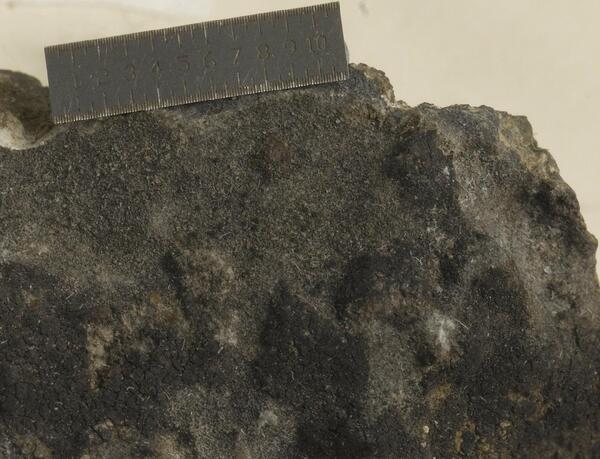Verrucaria praerupta Anzi
Atti Soc. Ital. Sci. Nat., 11: 173, 1868.
Synonyms:
Distribution: N - Lomb (Breuss & Berger 2010).
Description: Thallus crustose, episubstratic, areolate, 0.15-0.3 mm thick, medium to dark brown, brown-black in exposed sites, dull, often delimited by a thin, black prothallus, the areoles polygonal, 0.2-0.7 mm wide, flat, contiguous. Cortex thin; algal layer continuous, concentrated in the upper half of thallus; medulla colourless to brown, sometimes black in the lowermost part. Perithecia black, immersed to slightly projecting. Involucrellum reaching to base-level, adpressed to exciple, c. 50 μm thick; exciple subglobose, 0.15-0.3 mm across, the wall black throughout; hamathecium of short (c. 50 μm), simple periphyses and periphysoids, interascal filaments absent; hymenial gel hemiamyloid, I+ red (I+ blue at very low concentrations of I), K/I+ blue. Asci 8-spored, clavate, I-, fissitunicate, the wall thickened above, with an ocular chamber, dehiscent by extrusion of an endotunica to form a delicate rostrum, Verrucaria-type. Ascospores 1-celled, hyaline, broadly ellipsoid, 13-18 x 8-10(-11) μm. Photobiont chlorococcoid. Spot tests: K-, C-, KC-, P-, UV-. Chemistry: without lichen substances.
Note: closely related to V. nigrescens, but differing in several important morphological characters, this poorly known species occurs on calcareous rocks in upland areas; it is also known from the Austrian Alps (see Breuss & Berger, 2010) and from the Haute Savoye in France (Roux & coll., 2014).
Growth form: Crustose
Substrata: rocks
Photobiont: green algae other than Trentepohlia
Reproductive strategy: mainly sexual
Pioneer species
Poorly known taxon in need of further study
Commonnes-rarity: (info)
Alpine belt: very rare
Subalpine belt: very rare
Oromediterranean belt: absent
Montane belt: absent
Submediterranean belt: absent
Padanian area: absent
Humid submediterranean belt: absent
Humid mediterranean belt: absent
Dry mediterranean belt: absent

Predictive model
Growth form: Crustose
Substrata: rocks
Photobiont: green algae other than Trentepohlia
Reproductive strategy: mainly sexual
Pioneer species
Poorly known taxon in need of further study
Commonnes-rarity: (info)
Alpine belt: very rare
Subalpine belt: very rare
Oromediterranean belt: absent
Montane belt: absent
Submediterranean belt: absent
Padanian area: absent
Humid submediterranean belt: absent
Humid mediterranean belt: absent
Dry mediterranean belt: absent

Predictive model
 Index Fungorum
Index Fungorum
 GBIF
GBIF



